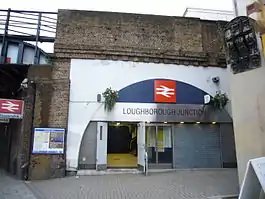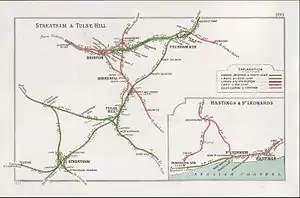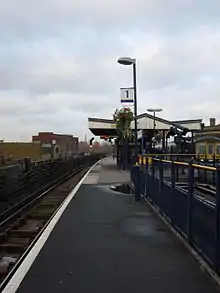Loughborough Junction railway station
Loughborough Junction railway station is in Loughborough Junction, Brixton in the London Borough of Lambeth. It is between Elephant & Castle and Herne Hill stations and is served by Thameslink.
| Loughborough Junction | |
|---|---|
 The station entrance on 2 January 2007 | |
 Loughborough Junction Location of Loughborough Junction in Greater London | |
| Location | Brixton |
| Local authority | London Borough of Lambeth |
| Managed by | Thameslink |
| Station code | LGJ |
| DfT category | E |
| Number of platforms | 2 |
| Fare zone | 2 |
| National Rail annual entry and exit | |
| 2015–16 | |
| 2016–17 | |
| 2017–18 | |
| 2018–19 | |
| 2019–20 | |
| Railway companies | |
| Original company | London, Chatham and Dover Railway |
| Key dates | |
| Oct 1864 | Brixton spur platforms opened as "Loughborough Road". |
| 1 Dec 1872 | Main line and Cambria spur platforms opened. Station renamed "Loughborough Junction" |
| 3 April 1916[2] | Brixton spur platforms closed |
| 12 July 1925 | Cambria spur platforms closed |
| Other information | |
| External links | |
| WGS84 | 51.4661°N 0.102°W |
History
In the 1860s the London, Chatham and Dover Railway (LCDR) opened its City Branch to central London. The line remains in use; since 1990 it has been part of the Thameslink route.

In October 1864 the LCDR opened Loughborough Road station on the north-to-west Brixton spur which connects the City Branch to the original Chatham main line at Brixton station. On 1 December 1872 platforms were opened on the City branch and on the north-to-east spur (called the Cambria Road platforms and spur after nearby Cambria Road). The enlarged station was renamed Loughborough Junction. The Loughborough Road platforms closed permanently on 3 April 1916 as a wartime economy measure, by 1916 all LCDR City branch stations south of the River Thames had been closed except Loughborough Junction and Elephant & Castle. In connection with the Southern Railway suburban electrification the platforms on Cambria Jn spur could not be lengthened so were closed on 12 July 1925.
After nationalisation the station was part of the Southern Region of British Railways and, from 1986, Network SouthEast. Around 1990 the station became part of the Thameslink route.
Services

Since September 2014, the Thameslink line has been part of Thameslink and Great Northern. Most passenger services from Loughborough Junction run between St Albans and Sutton. Some peak-hour Southeastern services between London Blackfriars and Beckenham Junction also call here.
| Preceding station | Following station | |||
|---|---|---|---|---|
| Elephant & Castle | Thameslink Thameslink |
Herne Hill | ||
| Elephant & Castle | Southeastern Blackfriars to Beckenham Junction |
Herne Hill | ||
| Historical railways | ||||
| Camberwell | London, Chatham and Dover Railway City Branch 1864-1916 |
Herne Hill | ||
| Camberwell | London, Chatham and Dover Railway City Branch 1864-1916 |
Brixton | ||
| Camberwell | London, Chatham and Dover Railway City Branch 1864-1916 |
Denmark Hill | ||
Connections
London Buses routes 35, 45, 345, P4 and P5 and night route N35 serve the station.
Future proposals


The South London line passes across the south end of Loughborough Junction station via a bridge but has never had platforms there. As part of phase 2 of the East London line extension project, this line is now part of the London Overground network operated by Transport for London. Completed on 9 December 2012, this extension connected the South London Line to the East and West London lines, allowing rail services to run across South London from Surrey Quays to Clapham Junction.[3] This creates an orbital network around Central London, fulfilling the Orbirail concept.[4]
The new route passes over both Loughborough Junction and Brixton stations,[3] and the proposals were criticised for not including new interchange stations at these locations.[5][6] No London Overground platforms are planned at Loughborough Junction as the line is on high railway arches, making the cost of any station construction prohibitive.[7] It has been proposed, as an alternative, that the disused East Brixton could be reopened instead as the site is close to both stations.[8][9]
See also
| LC&DR's Metropolitan Extensions and neighbouring railway lines | |||||||||||||||||||||||||||||||||||||||||||||||||||||||||||||||||||||||||||||||||||||||||||||||||||||||||||||||||||||||||||||||||||||||||||||||||||||||||||||||||||||||||||||||||||||||||||||||||||||||||||||||||||||||||||||||||||||||||||||||||||||||||||||||||||||||||||||||||||||||||||||||||||||||||||||||||||||||||||||||||||||||||||||||||||||||||||||||||
|---|---|---|---|---|---|---|---|---|---|---|---|---|---|---|---|---|---|---|---|---|---|---|---|---|---|---|---|---|---|---|---|---|---|---|---|---|---|---|---|---|---|---|---|---|---|---|---|---|---|---|---|---|---|---|---|---|---|---|---|---|---|---|---|---|---|---|---|---|---|---|---|---|---|---|---|---|---|---|---|---|---|---|---|---|---|---|---|---|---|---|---|---|---|---|---|---|---|---|---|---|---|---|---|---|---|---|---|---|---|---|---|---|---|---|---|---|---|---|---|---|---|---|---|---|---|---|---|---|---|---|---|---|---|---|---|---|---|---|---|---|---|---|---|---|---|---|---|---|---|---|---|---|---|---|---|---|---|---|---|---|---|---|---|---|---|---|---|---|---|---|---|---|---|---|---|---|---|---|---|---|---|---|---|---|---|---|---|---|---|---|---|---|---|---|---|---|---|---|---|---|---|---|---|---|---|---|---|---|---|---|---|---|---|---|---|---|---|---|---|---|---|---|---|---|---|---|---|---|---|---|---|---|---|---|---|---|---|---|---|---|---|---|---|---|---|---|---|---|---|---|---|---|---|---|---|---|---|---|---|---|---|---|---|---|---|---|---|---|---|---|---|---|---|---|---|---|---|---|---|---|---|---|---|---|---|---|---|---|---|---|---|---|---|---|---|---|---|---|---|---|---|---|---|---|---|---|---|---|---|---|---|---|---|---|---|---|---|---|---|---|---|---|---|---|---|---|---|---|---|---|---|---|---|---|---|---|---|---|---|---|---|---|---|---|---|---|---|---|---|---|---|---|---|
| |||||||||||||||||||||||||||||||||||||||||||||||||||||||||||||||||||||||||||||||||||||||||||||||||||||||||||||||||||||||||||||||||||||||||||||||||||||||||||||||||||||||||||||||||||||||||||||||||||||||||||||||||||||||||||||||||||||||||||||||||||||||||||||||||||||||||||||||||||||||||||||||||||||||||||||||||||||||||||||||||||||||||||||||||||||||||||||||||
- Loughborough Junction - the area around the station
References
- "Station usage estimates". Rail statistics. Office of Rail Regulation. Please note: Some methodology may vary year on year.
- Chronology of London Railways by H.V.Borley
- Transport for London (2006). "The Tube in 2010". Archived from the original on 1 October 2007. Retrieved 3 November 2007. (map illustrating future development phases as proposed by TfL in 2006, subject to change)
- Rail Express issue 154, March 2009
- "Junction joy South". South London Press (archived). 24 April 2004. Archived from the original on 9 May 2004. Retrieved 3 November 2009.
- Martin Linton MP (4 August 2006). "Parliamentary Debate: London Orbital Rail Network". Hansard. Retrieved 3 November 2007.
- "East London Line Extensions - Loughborough Junction". AlwaysTouchOut. 9 November 2006. Retrieved 3 November 2007.
- "Connecting Brixton to the London Overground. Petition launched to reopen East Brixton station". Brixton Buzz. 18 February 2014. Retrieved 24 October 2018.
- Cobb, Jason (21 March 2017). "Lambeth Council starts review to look at business case for reopening East Brixton train station". Brixton Buzz. Retrieved 24 October 2018.
External links
| Wikimedia Commons has media related to Loughborough Junction railway station. |
- Train times and station information for Loughborough Junction railway station from National Rail
- Subterranea Britannica article - includes photographs and map of this station and Camberwell New Road station
- LJ4D project - a virtual 3d model which documents the evolution of the station and surrounding area over time